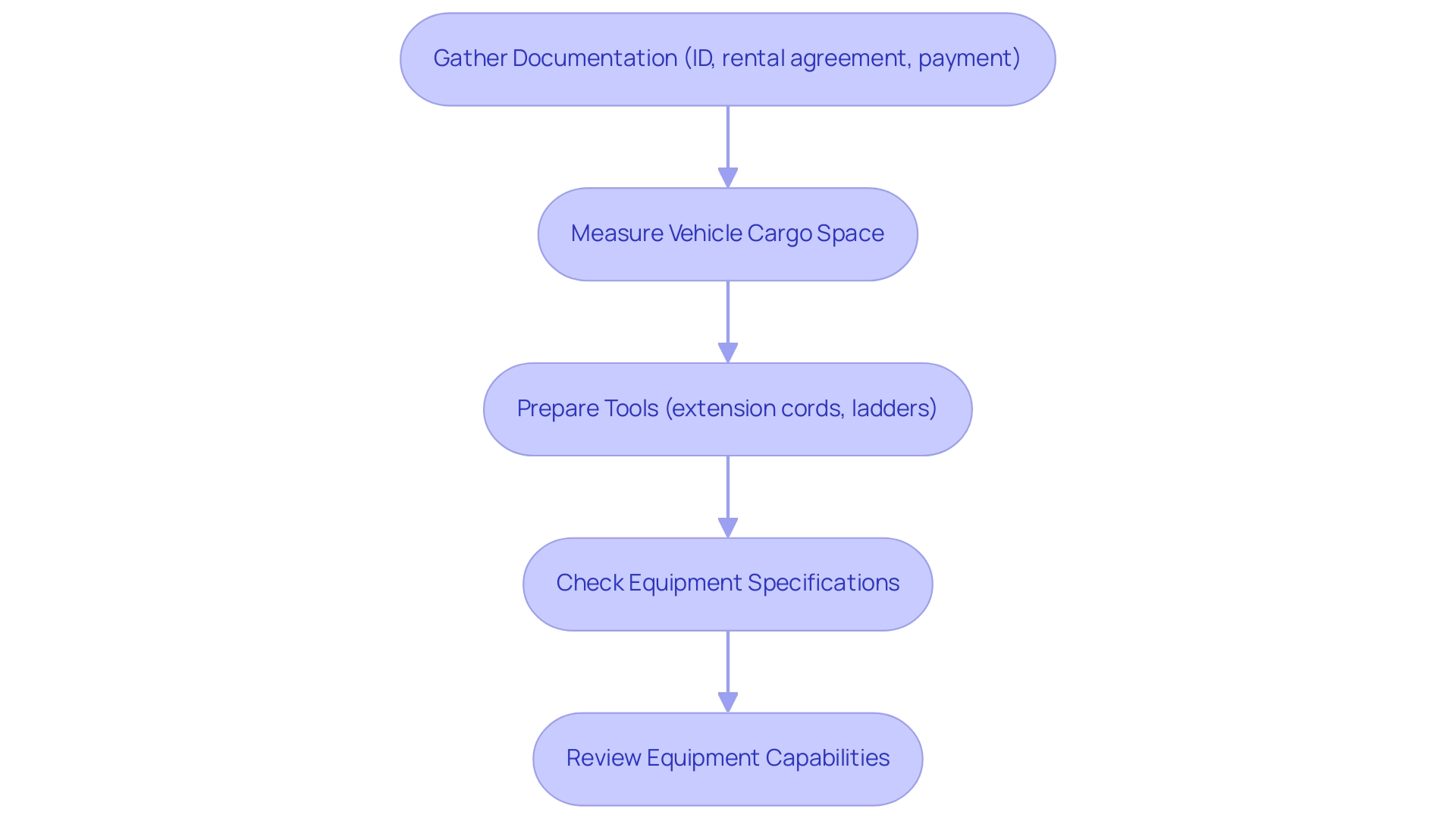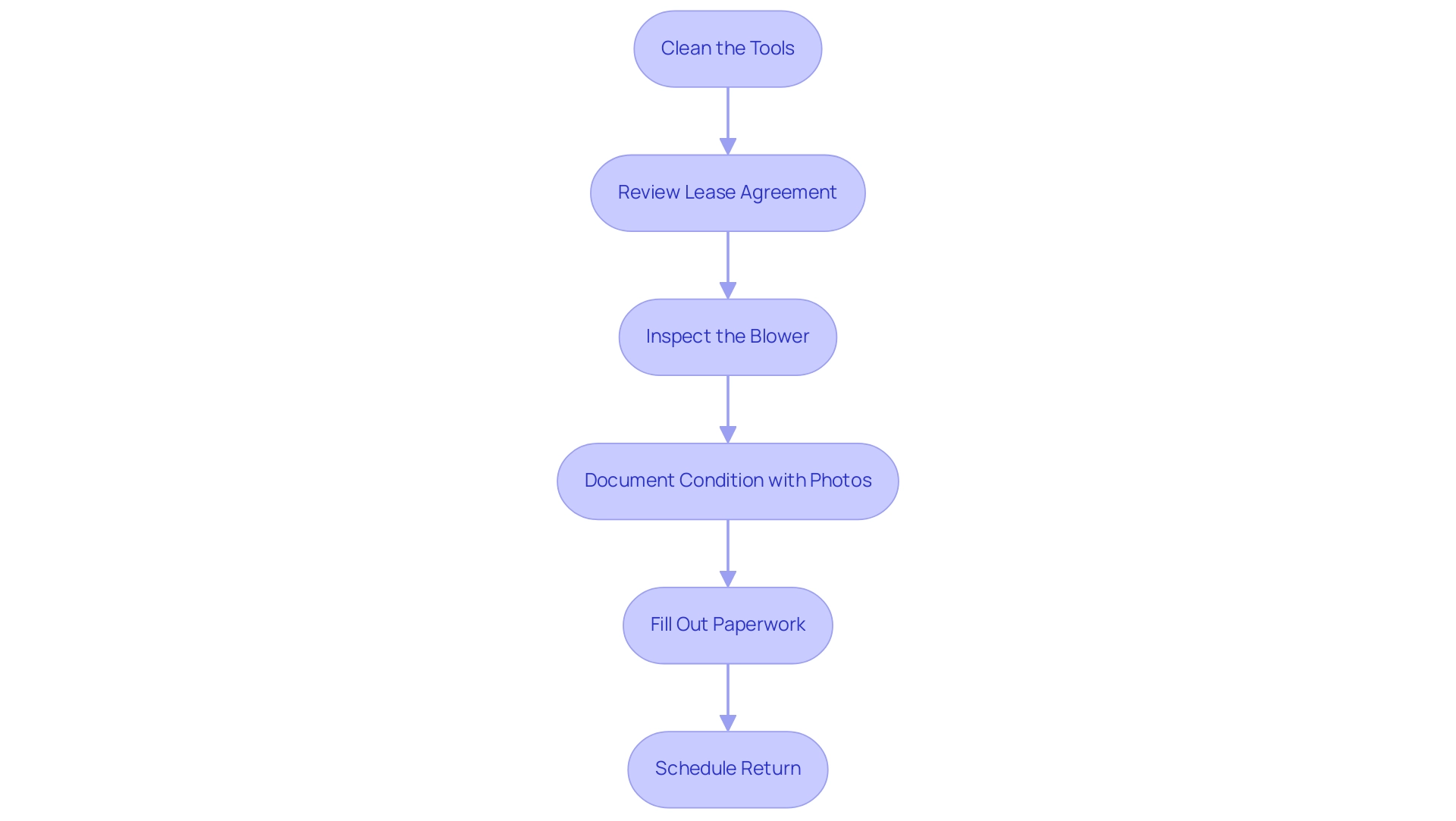Introduction
Navigating the world of insulation blower rentals can feel overwhelming, especially for those embarking on home improvement projects. With a growing demand for equipment rentals, understanding how to efficiently find, rent, and return an insulation blower is essential for success.
From identifying reliable local rental services to ensuring safe operation and proper return procedures, each step plays a critical role in maximizing the rental experience. This guide offers valuable insights and practical tips to streamline the process, helping individuals tackle their insulation needs with confidence and ease.
Finding Local Insulation Blower Rental Services
Finding local insulation blower leasing services in Irving, TX, can be streamlined by starting with a targeted online search using phrases like 'rent insulation blower near me' or 'equipment leasing services in Irving, TX.' Major retailers like Home Depot and Lowe's, along with specialized tool leasing companies in the DFW Metroplex, often list a variety of available tools, including:
- Boom lifts
- Mini excavators
- Trailers that you might also need for your project
Exploring local classifieds, community boards, and social media groups can yield valuable listings and insights into local options.
Personal recommendations from friends or family can provide trustworthy leads, reinforcing the importance of community networks in this search. According to recent data, the U.S. tool leasing market size in 2022 was estimated at 52.7 billion USD, indicating strong demand for leasing services and emphasizing the necessity of finding dependable options for your projects. Additionally, as U.S. import prices rose by 0.1% in November 2024, understanding how these economic factors influence housing costs is crucial.
After creating a list of possible leasing services, including those providing trailers, lifts, and other essential items, it’s crucial to read customer reviews and testimonials to assess their reliability and service quality. This process not only aids in choosing a reputable provider but also guarantees that you acquire the right equipment for your project requirements, particularly in a competitive market influenced by recent trends in heavy construction equipment.
Understanding the Rental Process for Insulation Blowers
When embarking on the journey of renting an insulation blower near me, the first step is to connect with your chosen service to assess availability. It's vital to inquire about flexible leasing duration options, especially if you need to rent an insulation blower near me, as many providers cater to various needs with daily, weekly, or monthly rates. Prepare to present identification and, in some cases, a deposit to secure your lease when you rent insulation blower near me.
Importantly, 100% of reviewers would recommend this product to a friend, which can bolster your confidence in the rental decision. Before finalizing your agreement to rent insulation blower near me, clarify any potential additional fees that may arise, such as delivery charges or insurance for the equipment. Understanding these elements can prevent unexpected costs and enhance your budgeting process.
The device can push out 350 pounds of insulation per hour and weighs 177 pounds, which is crucial for understanding transport requirements. Once the terms are clear, it’s crucial to request a comprehensive demonstration of the blower’s operation to ensure safe and effective use. Examine the lease agreement thoroughly, paying special attention to the return policy and any maintenance responsibilities during your occupancy period.
This diligence is not only advantageous for the implementation of your project but also aligns with expert advice on maximizing the efficiency of your experience when you rent insulation blower near me. As highlighted by industry specialist Kate Fann:
The R-value of the thermal barrier can make all the difference in keeping your home protected, but it depends on where you reside.
This insight highlights the importance of selecting the appropriate equipment for your specific thermal needs.
Moreover, utilizing tactics from the case study on cost-reduction suggestions for leasing a blowing machine—such as preparing the installation area and comparing prices—can greatly reduce overall expenses.
Preparing for the Rental Pickup
Before going out to collect your equipment, it’s essential to gather all necessary documentation, including your ID, rental agreement, and payment method. Considering that thermal machines weigh approximately 177 pounds and can expel up to 350 pounds of material per hour, it’s essential to think about a vehicle able to carry such large equipment. If possible, measure your vehicle's cargo space to ensure a comfortable fit for the blower.
Additionally, it’s wise to prepare any tools you might need for setup, such as extension cords or ladders, based on the specific requirements of your project. Dense packed cellulose material has an R-factor of 3.9 to 4.0, indicating its effectiveness in thermal resistance, which is a critical factor to consider when planning your project. As Joe Dickman wisely advises, "With the goal of understanding what you’re buying, read this guide to spec’ing refrigerated vehicles," this principle applies equally to equipment rentals.
A well-prepared approach not only saves you time but also helps you avoid any last-minute obstacles during the pickup process. For instance, in a case study involving a homeowner named CowDoc, he initially considered using a drum-type insulation device as a vacuum for moving insulation between rooms. However, he discovered that the device's design would not function as intended and ultimately opted for a portable dust collector instead.
This scenario illustrates the importance of understanding the equipment's capabilities and preparing accordingly, allowing you to focus on the job ahead.

Using the Insulation Blower Safely and Effectively
Ensuring safety during the operation of the thermal equipment is crucial for a successful installation. Begin by donning appropriate safety gear, including goggles, gloves, and a dust mask, to shield yourself from airborne particles that can cause respiratory or eye injuries. According to safety statistics, improper use of insulation machines can lead to injuries such as respiratory issues, eye injuries, and even falls due to tripping hazards, making adherence to safety guidelines essential.
Before starting, meticulously read the manufacturer’s instructions to familiarize yourself with the equipment’s features and limitations. Positioning the fan in a well-ventilated area is essential; this not only improves comfort but also reduces the risk of inhaling harmful particles. Ensure that all hoses are securely connected and practice on a small area to gain confidence in the operation while adjusting the flow rate as necessary.
Regularly inspect the hoses for blockages during use and maintain a clean workspace to prevent tripping hazards. By following these safety protocols, you can establish a safe setting for material installation, aiding in the reduction of typical injuries linked to incorrect use of insulation machinery. Furthermore, understanding the lifespan of various thermal barriers is important; for instance, blown-in material typically lasts 25 to 50 years, while spray foam can last 80 to 100 years.
This long-term perspective highlights the significance of using thermal application machines efficiently and securely in contemporary building practices. As emphasized in the case study on Aerogel material, known for its exceptional thermal performance, effective usage of blowers can significantly impact quality. As Inemesit Ukpanah observes, with ongoing advancements in materials and techniques, the function of thermal barriers in environmental protection and energy efficiency will only grow stronger in years to come.
This highlights the essential importance of appropriate thermal barrier practices.
Returning the Insulation Blower
To ensure a smooth return of your insulation blower and avoid any unexpected fees, start by cleaning the tools thoroughly, removing all debris and dust. This proactive step is crucial, especially considering that in Virginia, cleaning costs for leased properties have increased significantly, with 1-bedroom cleaning costs rising by 20.12%. Rental companies often impose cleaning fees if equipment is not returned in proper condition.
Review your lease agreement for specific return instructions, including time and location, and schedule your return accordingly to avoid late fees. During the return process, conduct a thorough inspection of the blower for any potential damage or operational issues that may have arisen during your usage period. If any discrepancies are found, report them to the leasing service immediately.
It can be beneficial to take photos of the tools from multiple angles upon return to document their condition and protect yourself against potential damage claims. Furthermore, as Brian Boucher recommends, utilizing the square footage guideline, allocate $1 per square foot annually when planning for possible expenses related to equipment. Ensure that all leasing paperwork is accurately filled out, and keep a copy of the receipt for your records.
By following these steps, you can efficiently return the insulation blower, maintain a positive rapport with the rental service, and mitigate any risk of incurring extra costs, especially in light of rising cleaning fees illustrated by case studies on average Airbnb cleaning costs, while also considering where to rent insulation blower near me.

Conclusion
Finding the right insulation blower rental service is the first step towards a successful home improvement project. By conducting a thorough search and leveraging local resources, individuals can connect with reliable rental providers that meet their specific needs. Understanding the rental process, including the terms, costs, and required documentation, ensures a seamless experience from start to finish.
Preparation plays a critical role in maximizing efficiency during the rental period. Gathering necessary tools, ensuring proper transport, and familiarizing oneself with the equipment are essential actions that can prevent delays and complications. Safety should never be overlooked; adhering to guidelines not only protects the individual but also contributes to a successful insulation installation.
Upon completion of the project, returning the insulation blower in good condition is vital to avoid unexpected fees. Cleaning the equipment, inspecting for damages, and following return instructions will help maintain a positive relationship with the rental service. By approaching the entire process with diligence and preparation, individuals can confidently tackle their insulation needs, ensuring their home remains energy-efficient and comfortable for years to come.
Frequently Asked Questions
How can I find local insulation blower leasing services in Irving, TX?
You can find local insulation blower leasing services by conducting an online search using phrases like 'rent insulation blower near me' or 'equipment leasing services in Irving, TX.' Major retailers such as Home Depot and Lowe's, as well as specialized tool leasing companies in the DFW Metroplex, often list available tools.
What types of equipment can I expect to find for lease in the DFW Metroplex?
You can expect to find a variety of equipment for lease, including boom lifts, mini excavators, and trailers that may be needed for your project.
Where else can I look for insulation blower leasing options besides major retailers?
You can explore local classifieds, community boards, and social media groups for valuable listings and insights into local leasing options. Personal recommendations from friends or family can also provide trustworthy leads.
What should I consider when renting an insulation blower?
When renting an insulation blower, assess availability with your chosen service, inquire about flexible leasing duration options, and be prepared to present identification and possibly a deposit. It's also important to clarify any potential additional fees, such as delivery charges or insurance.
What are the specifications of the insulation blower?
The insulation blower can push out 350 pounds of insulation per hour and weighs 177 pounds, which is important for understanding transport requirements.
What steps should I take before finalizing my rental agreement?
Before finalizing your rental agreement, clarify any potential additional fees, request a comprehensive demonstration of the blower’s operation, and thoroughly examine the lease agreement, paying special attention to the return policy and maintenance responsibilities during your rental period.
Why is it important to understand the R-value of the thermal barrier?
The R-value of the thermal barrier is crucial for keeping your home protected, and it depends on your specific location. Selecting the appropriate equipment for your thermal needs is essential for effective insulation.
What strategies can help reduce costs when leasing an insulation blower?
Strategies to reduce costs include preparing the installation area and comparing prices among different leasing services.




